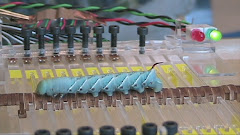Manduca caterpillar only represents a class of Lepidoptera with four abdominal prolegs. Many other species have reduced the size or number of prolegs. Geometrids (loopers, inchworms, and spanworms), for example, retain only the A6 abdominal prolegs which work in conjunction with the terminal (anal) prolegs to facilitate the rear end attachment during a looping action. Lepidoptera larvae in the limacodid-group have very short legs at the belly that their modes of locomotion resemble slug creeping in apparence. For these so called "slug caterpillars", there can be abdominal prolegs from A2 to A7 with a combination of crochets and suckers. After starring at the "typical" 4-Abd prolegs caterpillars for three years, I start to wonder how the differences among these locomotor modes are associated with the evolution of these three forms of caterpillars. First thing that came to my mind was the mass scaling issue. According to my experiences with live caterpillars in the wild, 4 Abd body plan is common in species that can get really big and juicy. Inchworms are rarely bigger than 5cm. Slug caterpillars seems even smaller.
Larger caterpillars --- 4 Abd prolegs (use as many body anchors as the locomotion allows)
Loopers/Inchworm --- 1~3 Abd prolegs (reduce unneccessary attachements for efficiency)
Slug caterpillars --- short prolegs close to the ventrum (increase contact surface for fluid/silk adhesion mechanism)
This line of reasoning is very consistent with my current biomechanical finding: prolegs=attachments. (results from the caterpillar substrate reaction force analysis) Since soft legs cannot provide effective leverage, they are just acting as anchors for caterpillars. And it follows that the evolutionary modifications of prolegs morphologies should be determined by the maximum body size and mechanisms of attachement.
Subscribe to:
Post Comments (Atom)

.jpg)
No comments:
Post a Comment